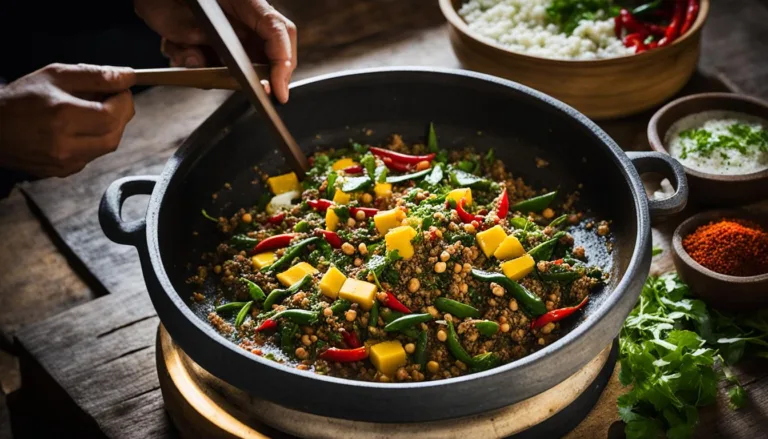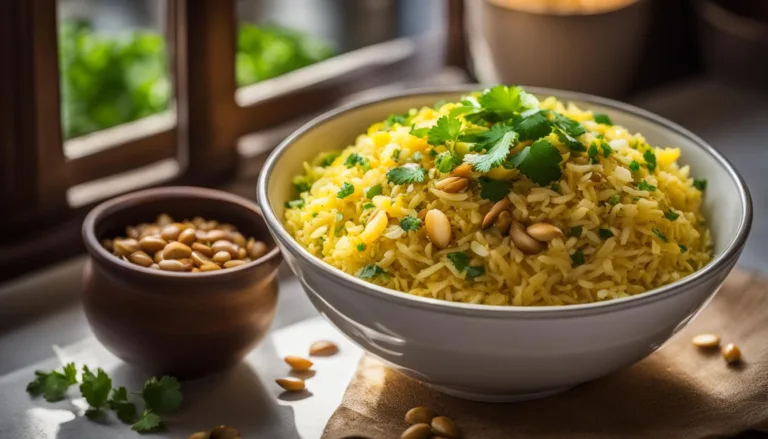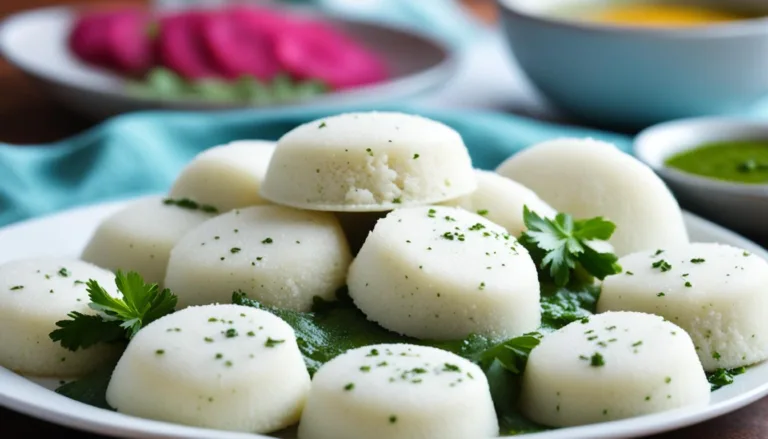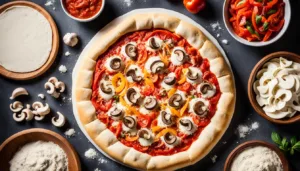Welcome to our Ultimate Homemade Pizza Recipe Guide! If you’re craving the perfect pizza made right at home, you’ve come to the right place. Homemade pizza offers a whole world of culinary possibilities, allowing you to customize every aspect of your pie and achieve pizza perfection.
Whether you’re a seasoned pizza enthusiast or a beginner ready to embark on your pizza-making journey, this guide is designed to equip you with the knowledge and techniques to create homemade pizzas that will rival your favorite pizzerias.
Table of Contents
Key Takeaways:
- Homemade pizza allows you to customize toppings and control the quality of ingredients.
- The right tools, such as a pizza stone and pizza peel, are essential for success.
- The perfect pizza dough is the foundation for a flavorful crust.
- Creating homemade sauce enhances the overall flavor of your pizza.
- Choosing the right toppings and flavor pairings elevates your pizza experience.
Embarking on the Pizza-Making Journey
When it comes to crafting your own pizza at home, the possibilities are endless. There is something undeniably alluring about the process of pizza-making, from kneading the dough to selecting the perfect combination of toppings. Not only does it allow you to unleash your creativity in the kitchen, but it also provides a satisfying and delicious end result.
The Allure of Crafting Your Own Pizza
There are several reasons why people are drawn to the idea of making pizza from scratch. Here are a few:
- Customization: Crafting your own pizza allows you to customize every aspect according to your personal taste preferences. From the type and amount of cheese to the selection of toppings, you have full control over the flavor profile of your pizza.
- Quality Control: Making pizza at home ensures that you have complete control over the quality of ingredients used. You can choose to use fresh, locally sourced produce and high-quality cheeses and meats, resulting in a pizza that is not only delicious but also wholesome.
- Culinary Adventure: Pizza-making is an opportunity to embark on a culinary adventure, experimenting with different flavor combinations and techniques. It allows you to expand your culinary skills and knowledge while having fun in the process.
The Essential Tools for a Perfect Pizza
To craft the perfect homemade pizza, you’ll need a few essential tools. Here are the must-haves:
| Tool | Description |
|---|---|
| Pizza Stone | A pizza stone is a crucial tool for achieving a crispy crust. It helps distribute heat evenly, resulting in a perfectly baked pizza. |
| Pizza Peel | A pizza peel is used to transfer the pizza onto the hot pizza stone in the oven. It ensures ease of handling and prevents dough from sticking to the surface. |
| Rolling Pin | A rolling pin is essential for rolling out the dough to the desired thickness. It helps create an even crust and facilitates easy shaping. |
| Pizza Cutter | A pizza cutter is necessary for slicing the pizza into perfect portions. It ensures clean cuts without crushing the toppings. |
With these essential tools in your kitchen arsenal, you’ll be well-equipped to embark on your pizza-making journey.

The Perfect Pizza Dough: A Foundation for Flavor
The secret to a truly delicious homemade pizza lies in the quality of the pizza dough. A flavorful crust sets the stage for a memorable pizza experience, and that’s why we’re here to share our recipe for the perfect homemade pizza dough.
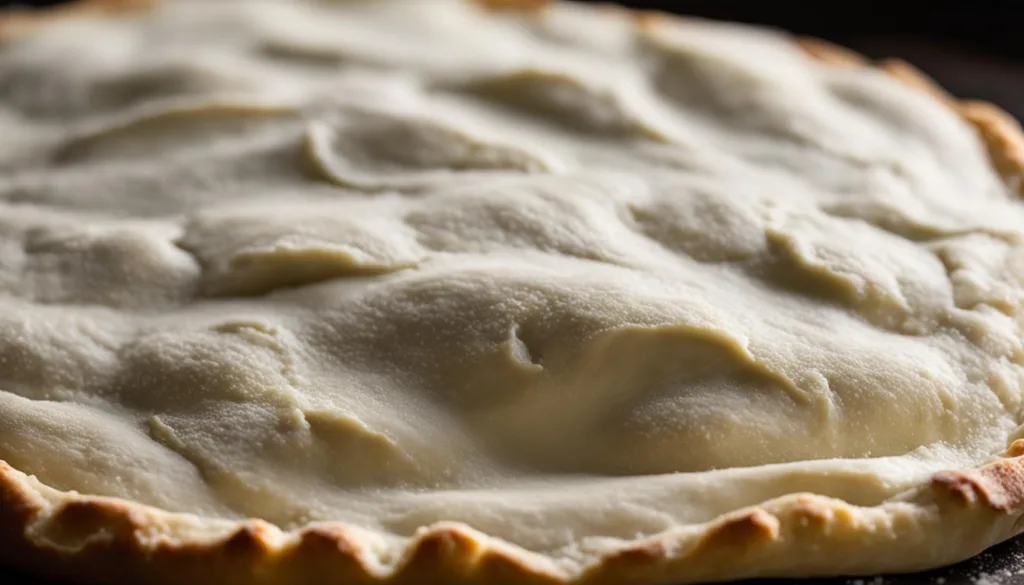
Making your own pizza dough allows you to control every aspect of the process, from the ingredients to the technique. By using fresh, high-quality ingredients and following our step-by-step instructions, you can create a dough that is both tender and full of flavor.
To achieve the best results, you’ll need the following ingredients:
- 3 cups all-purpose flour
- 2 teaspoons instant yeast
- 2 teaspoons salt
- 1 1/4 cups warm water
- 2 tablespoons olive oil
Begin by combining the flour, yeast, and salt in a large mixing bowl. In a separate bowl, mix together the warm water and olive oil. Gradually pour the wet ingredients into the dry ingredients, stirring with a spoon until a shaggy dough forms.
Next, transfer the dough to a lightly floured surface and knead it for about 5 minutes, until it becomes smooth and elastic. If the dough feels too sticky, you can add a little more flour, a tablespoon at a time.
After kneading, place the dough in a greased bowl and cover it with a clean kitchen towel. Allow it to rise in a warm, draft-free area for about 1 to 2 hours, or until it has doubled in size.
Once the dough has risen, gently punch it down to release any air bubbles. Divide the dough into two equal portions if you’re making two pizzas. Roll each portion into a ball and let them rest for 15 minutes, covered with a towel.
At this point, your homemade pizza dough is ready to be shaped, topped, and baked to perfection. With its amazing flavor and texture, it will serve as the foundation for a truly delicious homemade pizza that will delight your family and friends.
Mastering the Art of Pizza Sauce
When it comes to creating the perfect homemade pizza, the sauce plays a crucial role in enhancing the flavor profile. A well-crafted pizza sauce can elevate the taste of your pizza and turn it into a culinary masterpiece. In this section, we will guide you through the process of making your own delicious pizza sauce at home.
To create a homemade pizza sauce that brings out the best flavors in your pizza, you will need a few key ingredients:
- Tomatoes (fresh or canned)
- Olive oil
- Garlic
- Onion
- Herbs and spices (such as basil, oregano, and red pepper flakes)
- Salt and pepper
By using high-quality ingredients and taking control of the seasoning, you can customize the sauce to your taste preferences and ensure a truly unforgettable pizza experience. The homemade sauce allows you to adjust the level of tanginess, sweetness, and spiciness, providing a personalized touch to your pizza creation.

“Making your own pizza sauce gives you the opportunity to experiment with flavors and create a sauce that perfectly complements your toppings.”
To prepare the homemade pizza sauce, start by heating the olive oil in a saucepan over medium heat. Add the minced garlic and diced onion, cooking until they become fragrant and translucent. Next, add the tomatoes and seasonings, stirring to combine. Allow the sauce to simmer for about 20-30 minutes, or until it thickens to your desired consistency. Taste and adjust the seasonings as needed.
Once your pizza sauce is ready, you can store it in an airtight container in the refrigerator for up to one week. This allows you to make multiple pizzas or use the sauce for other delicious dishes throughout the week.
Remember, the homemade pizza sauce is the key to flavor enhancement and a true reflection of your creativity in the kitchen. Take the time to master the art of pizza sauce, and you’ll be rewarded with pizzas that are bursting with deliciousness.
| Pizza Sauce Recipe | Ingredients | Instructions |
|---|---|---|
| Homemade Pizza Sauce | 2 tablespoons olive oil | 1. Heat olive oil in a saucepan over medium heat. |
| 3 cloves garlic, minced | 2. Add minced garlic and cook until fragrant and translucent. | |
| 1 small onion, diced | 3. Add diced onion and cook until translucent. | |
| 1 can (14 ounces) diced tomatoes | 4. Add diced tomatoes and stir to combine. | |
| 1 teaspoon dried basil | 5. Add dried basil, salt, and pepper to taste. | |
| 6. Simmer the sauce for 20-30 minutes, stirring occasionally, until thickened. |
Choosing the Right Toppings for Your Pizza Recipe
When it comes to creating the perfect pizza, the choice of toppings plays a crucial role. Whether you prefer traditional classics or are looking to embark on a more adventurous culinary journey, selecting the right toppings can make or break your pizza experience.
Traditional Toppings vs. Adventurous Additions
The world of pizza toppings offers a wide range of options, from the tried and true traditional choices to more daring and unconventional combinations. Traditional toppings like pepperoni, mushrooms, and cheese have stood the test of time for good reason – they are beloved by pizza enthusiasts all over the world.
However, if you’re feeling adventurous and want to push the boundaries of flavor, why not try some more daring additions? Toppings like arugula, prosciutto, and goat cheese can add a unique twist to your pizza and elevate it to new heights of culinary delight.
Remember, there are no hard and fast rules when it comes to pizza toppings. Feel free to experiment and create your own signature combinations that reflect your personal taste and culinary preferences.
Pairing Toppings for Ultimate Flavor Harmony
When selecting toppings for your pizza, the key is to strike a balance between flavors and textures. The right combination of ingredients can create a harmonious taste experience that tantalizes your taste buds.
For example, if you’re opting for a traditional Margherita pizza with fresh tomatoes, mozzarella, and basil, consider adding a sprinkle of balsamic glaze or a drizzle of extra virgin olive oil to enhance the flavors. The sweetness of the glaze and the richness of the olive oil can elevate the taste profile of the pizza.
If you’re going for an adventurous pizza topped with spicy sausage and jalapeños, pairing it with creamy ricotta cheese or tangy feta can help balance out the heat and add a delightful contrast of flavors.
Don’t be afraid to get creative with your toppings and explore different flavor pairings. Take inspiration from cuisines around the world and experiment with ingredients that complement each other to create an unforgettable pizza experience.
Whether you prefer the classic combination of pepperoni and cheese or enjoy the thrill of exploring unique topping combinations, the choice is yours. Let your taste buds guide you on a pizza adventure, and remember to have fun in the process!

Techniques for Shaping Your Pizza
The Secret to a Perfectly Rounded Crust
Shaping your pizza dough is an art that requires practice and precision. The key to achieving a perfectly rounded crust lies in the technique you use. Here’s a step-by-step guide to help you shape your dough:
- Start by gently flattening the dough with your hands, forming a rough circle.
- Using your fingertips, begin stretching and pulling the dough from the center to the edges, rotating it as you go. Work your way around the dough until it is evenly stretched.
- To create a beautifully rounded crust, use both hands to lift the dough from the edges and gently stretch it outwards. Gradually, let gravity help the dough stretch naturally, creating a round shape.
- As you shape the dough, ensure that the center remains slightly thicker than the edges. This will help the crust rise evenly during baking.
Thickness & Texture: Getting It Just Right
The thickness and texture of your pizza crust can greatly influence the overall eating experience. Here are some tips to help you achieve the perfect thickness and texture:
- If you prefer a thin and crispy crust, roll the dough out thinly using a rolling pin. This will result in a delicate and light texture.
- For a thicker and chewier crust, let the dough rise for a longer period of time. This will allow the yeast to develop, resulting in a more substantial texture.
- Experiment with different combinations of flour and hydration levels to achieve the desired texture. A higher hydration dough will generally yield a softer and airier crust.

The image above beautifully showcases the techniques for shaping your pizza dough, helping you achieve that perfectly rounded crust with the right thickness and texture.
Table: Pizza Thickness and Texture Guide
| Crust Type | Thickness | Texture |
|---|---|---|
| Thin and Crispy | 1/8 inch – 1/4 inch | Delicate and light |
| Medium | 1/4 inch – 1/2 inch | Substantial and chewy |
| Thick | 1/2 inch – 1 inch | Soft and doughy |
Use this table as a guide to determine the ideal thickness and texture for your pizza crust, based on your personal preferences and the style of pizza you aim to create.
Cooking Your Pizza to Perfection
In order to achieve a mouthwatering homemade pizza, it is essential to master the art of cooking it to perfection. The cooking process plays a crucial role in creating a crispy crust that is irresistibly delicious.
One of the key steps to ensure a crispy crust is preheating the oven. By preheating the oven, you allow the heat to evenly distribute and reach the desired temperature before placing your pizza inside. This helps in achieving an even bake and a well-cooked crust.
Another important factor to consider is the baking temperature. For a crispy crust, it is recommended to set the oven to a high temperature, typically around 475°F (245°C). The high heat helps in creating a golden brown and crispy texture on the crust, adding to the overall enjoyment of the pizza.
The cooking time and temperature may vary depending on the thickness of the pizza crust and the desired level of doneness. Thicker crusts generally require a longer cooking time, while thinner crusts may cook faster. It is important to monitor the pizza closely to achieve the desired level of crispiness and ensure that it doesn’t burn.
By following these guidelines and experimenting with different cooking times and temperatures, you can achieve a perfectly cooked pizza with a crispy crust that will impress your family and friends. So go ahead, fire up the oven, and savor the deliciousness of your homemade pizza!
The Science of Fermentation and Its Impact on Pizza Quality
In order to truly understand the art of pizza making, it is essential to explore the science behind one of its key elements: fermentation. Fermentation plays a crucial role in the development of pizza dough, influencing both its flavor and texture. By delving into the intricate process of fermentation, we can gain valuable insights into unlocking the full potential of our homemade pizzas.
Understanding Fermentation and Dough Development
Fermentation is a natural process that occurs when yeast interacts with sugars in the dough, producing carbon dioxide gas bubbles. This fermentation process leads to the dough rising and developing a light, airy structure. It also allows enzymes in the flour to break down complex starches into simpler forms, resulting in a more digestible and flavorful crust.
During fermentation, the yeast feeds on the sugars, producing alcohol and carbon dioxide as byproducts. The carbon dioxide gets trapped in the dough, causing it to rise. This trapped gas creates pockets within the dough, contributing to its characteristic texture and chewiness. Additionally, the alcohol produced by the yeast evaporates during baking, leaving behind an enhanced aroma and flavor.
As fermentation progresses, the gluten in the dough undergoes changes that contribute to its development and strength. The long, slow fermentation process allows the gluten strands to align and become more elastic, resulting in a dough that is easier to shape and stretch. This improved gluten structure also contributes to the final texture of the crust, with a desirable balance between softness and chewiness.
How Time and Temperature Influence Flavor
The duration and temperature at which fermentation takes place can significantly impact the flavor profile of the pizza. Longer fermentation times, such as overnight or up to 48 hours, allow for more flavor development as the enzymes have more time to break down starches and proteins. This extended fermentation also promotes the development of desirable aromatic compounds, resulting in a more complex and nuanced flavor.
Temperature also plays a crucial role in fermentation. Cooler temperatures slow down the fermentation process, allowing for more flavor development and a more pronounced tanginess. Conversely, warmer temperatures facilitate faster fermentation, resulting in a less complex flavor profile. Finding the ideal temperature for fermentation is a balance between time and flavor, with each contributing to the final taste of the pizza.
To achieve the best results in pizza making, it is important to optimize the fermentation process. This can be done by using the right amount of yeast, incorporating a slow, cold fermentation in the refrigerator, and allowing the dough to rise for an adequate amount of time. By understanding the science behind fermentation and its impact on dough development and flavor, we can elevate our homemade pizzas to new heights of excellence.
| Fermentation Tips | Impact on Pizza Quality |
|---|---|
| Use a small amount of yeast to promote a slow fermentation process | Develops a more complex flavor profile |
| Refrigerate the dough for 24 to 48 hours | Allows for enzyme activity and flavor development |
| Allow the dough to rise at room temperature for 2 to 4 hours | Results in a light, airy texture and improved gluten structure |
Pizza Recipe: Assembling the Ultimate Homemade Pizza
Now that we have perfected the pizza dough, sauce, and selected our toppings, it’s time to assemble the ultimate homemade pizza. Follow these step-by-step instructions to create a mouthwatering masterpiece right in your own kitchen.
- Preheat your oven to 475°F (245°C) and place a pizza stone on the center rack to ensure even heat distribution.
- Dust your work surface with flour and place the prepared pizza dough in the center. Using your hands or a rolling pin, gently stretch and shape the dough into a round or rectangular shape, depending on your preference.
- Transfer the shaped dough to a pizza peel or an inverted baking sheet dusted with flour or cornmeal to prevent sticking.
- Spread a generous amount of the homemade pizza sauce evenly over the dough, leaving a small border around the edges.
- Sprinkle a layer of your favorite cheese, such as mozzarella or a blend of cheeses, over the sauce.
- Add your desired toppings, whether it’s classic options like pepperoni and mushrooms, or more adventurous choices like arugula and grilled chicken.
- To prevent the toppings from burning, be sure not to overload the pizza.
- Transfer the assembled pizza carefully onto the preheated pizza stone in the oven.
- Bake for approximately 10-12 minutes, or until the crust is golden brown and the cheese is bubbly and melty.
- Using a pizza peel or a large spatula, carefully remove the hot pizza from the oven, and let it cool for a few minutes before slicing and serving.
There you have it! By following these simple steps, you can assemble an ultimate homemade pizza that rivals your favorite pizzeria. Get creative with your toppings and experiment with different flavor combinations to create your signature pizza masterpiece.
- Classic Coq au Vin Recipe – French Comfort Food

- Authentic Ema Datshi Recipe | Taste of Bhutan

- Creamy Chicken Butter Masala Recipe – Taste the special and the best!

Conclusion
As we reach the end of our ultimate homemade pizza recipe guide, we hope you are feeling inspired and ready to embark on your own pizza-making journey. Crafting homemade pizza is not just about creating a delicious meal, but also about the joy and satisfaction that comes from taking control of the ingredients, flavors, and techniques.
Throughout this guide, we have explored the essential tools, perfected the art of pizza dough, mastered the art of pizza sauce, and learned how to choose the right toppings for the ultimate flavor experience. We have also shared tips and techniques on shaping the perfect crust and cooking your pizza to crispy perfection.
Remember, the key to pizza perfection lies in your hands. Use this guide as a resource to continue experimenting and exploring. Adjust the toppings to suit your taste, try different sauce variations, and don’t be afraid to get creative with flavor pairings. The possibilities are endless!
So, what are you waiting for? It’s time to roll up your sleeves, get your pizza stone preheated, and unleash your inner pizzaiolo. We wish you all the success in your homemade pizza endeavors. Happy pizza-making!
FAQ
What are the benefits of making homemade pizza?
Making homemade pizza allows you to customize toppings, control the quality of ingredients, and enjoy the process of making food from scratch.
What tools do I need to make homemade pizza?
To make a successful homemade pizza, you’ll need a pizza stone, pizza peel, rolling pin, and pizza cutter.
What is the importance of pizza dough in creating a flavorful crust?
Pizza dough is the foundation of a flavorful crust. It provides the texture and flavor that make a pizza delicious.
Can you provide a recipe for homemade pizza dough?
Absolutely! Here’s a detailed recipe for homemade pizza dough, including the ingredients and step-by-step instructions.
What are the tips for kneading and proofing the pizza dough?
Kneading and proofing the dough properly are essential for achieving the perfect texture and flavor. Here are some tips and techniques to help you with the process.
How does pizza sauce enhance the flavor of the pizza?
Pizza sauce adds a delicious tang and enhances the flavor of the pizza. It brings all the ingredients together and gives the pizza its signature taste.
Do you have a recipe for homemade pizza sauce?
Yes! Here’s a recipe for homemade pizza sauce, including the ingredients and instructions for preparation.
Can I adjust the flavor of the pizza sauce to my preferences?
Absolutely! You can easily adjust the flavor of the pizza sauce by adding herbs, spices, or other ingredients to suit your taste.
What options do I have for pizza toppings?
You can choose from a variety of options for pizza toppings, including traditional choices like pepperoni, mushrooms, and cheese, as well as more adventurous options like arugula, prosciutto, and goat cheese.
How do I select toppings that create a harmonious taste experience?
Balancing flavors and textures is key when selecting pizza toppings. Here are some suggestions for flavor pairings that create a harmonious taste experience.
What techniques should I use to shape the pizza dough?
Shaping the pizza dough properly is important for achieving a perfectly rounded crust. Here are step-by-step instructions and tips for stretching and shaping the dough.
How important is pre-baking the crust?
Pre-baking the crust ensures an even bake and helps to prevent a soggy pizza. It’s an essential step for achieving a perfectly cooked pizza.
What is the best way to cook a homemade pizza?
Preheating the oven and using a high baking temperature is crucial for achieving a crispy crust. The cooking time and temperature will depend on the thickness of the crust and the desired level of doneness.
What is the role of fermentation in pizza dough?
Fermentation plays a vital role in developing flavors and improving the texture of the pizza dough. It adds complexity and depth to the final product.
How does time and temperature influence the flavor of the pizza?
Time and temperature have a significant impact on the flavor of the final pizza. They affect the fermentation process and can result in different flavor profiles.
Can you provide a detailed pizza recipe, including assembly?
Certainly! Here’s a detailed pizza recipe that includes instructions for assembling the ultimate homemade pizza with homemade dough, sauce, and toppings.
What are your final thoughts on the homemade pizza-making journey?
The satisfaction and enjoyment that can be achieved through crafting homemade pizza are unparalleled. We encourage you to use this guide as a resource to continue exploring and experimenting with your own pizza recipes.






